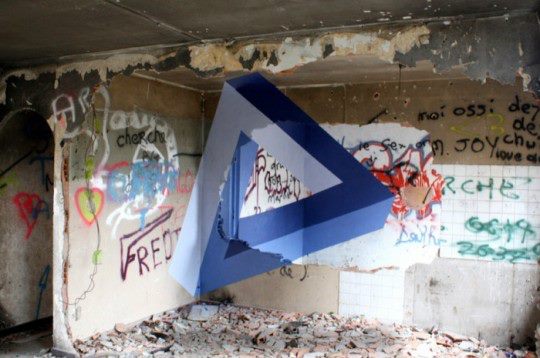

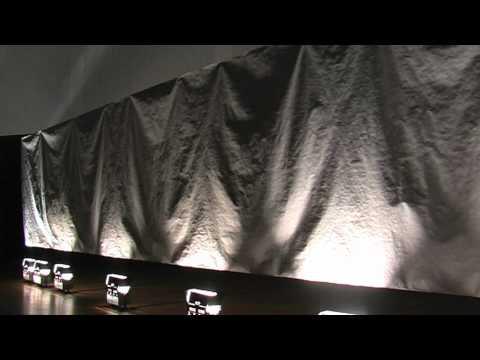
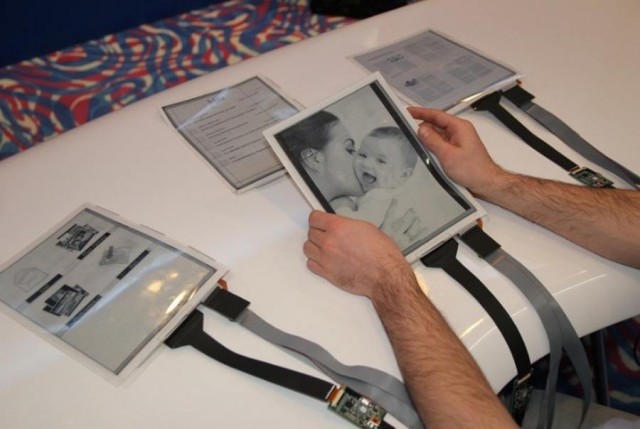
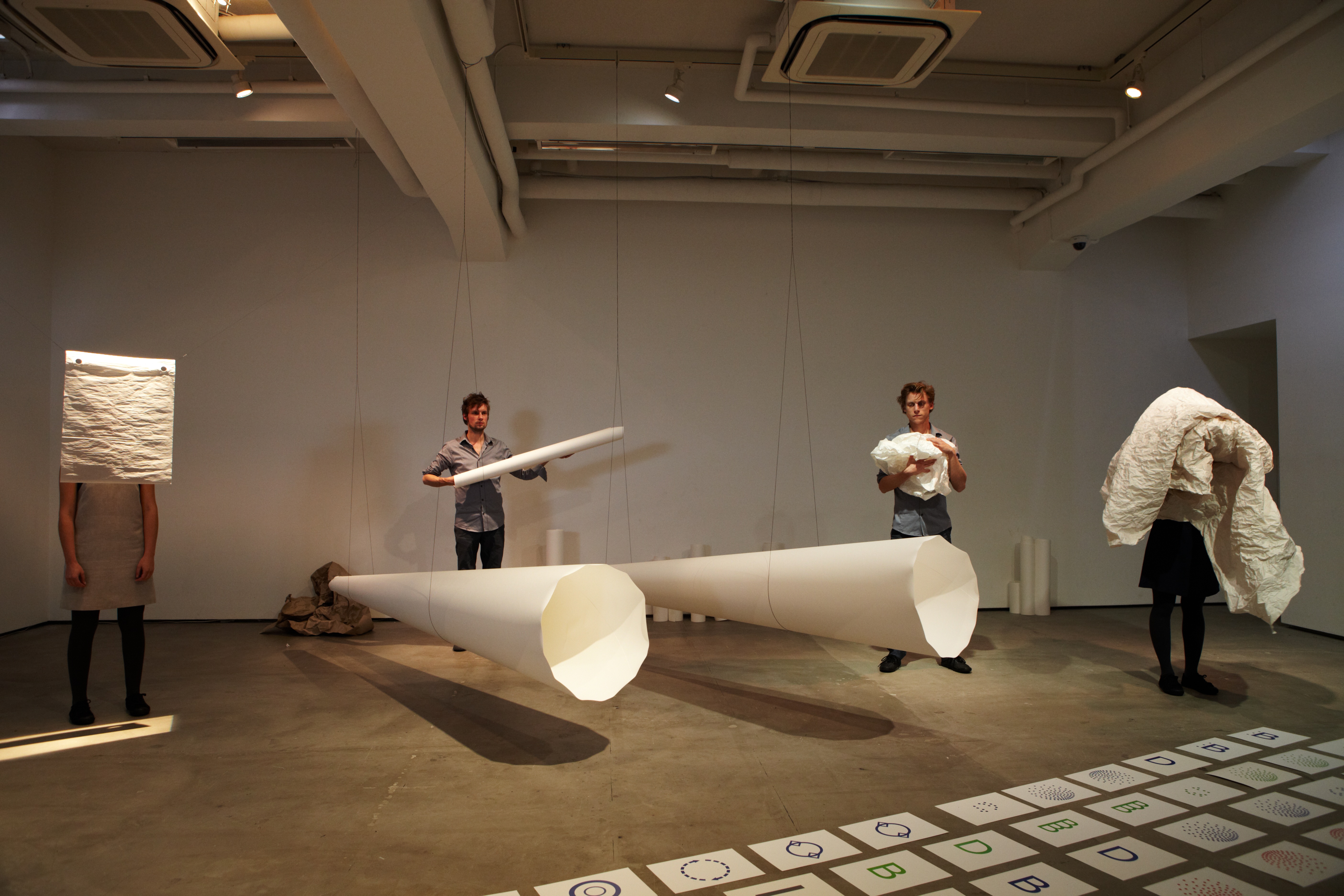
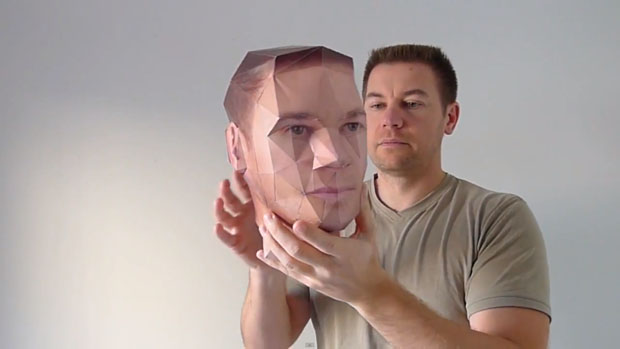
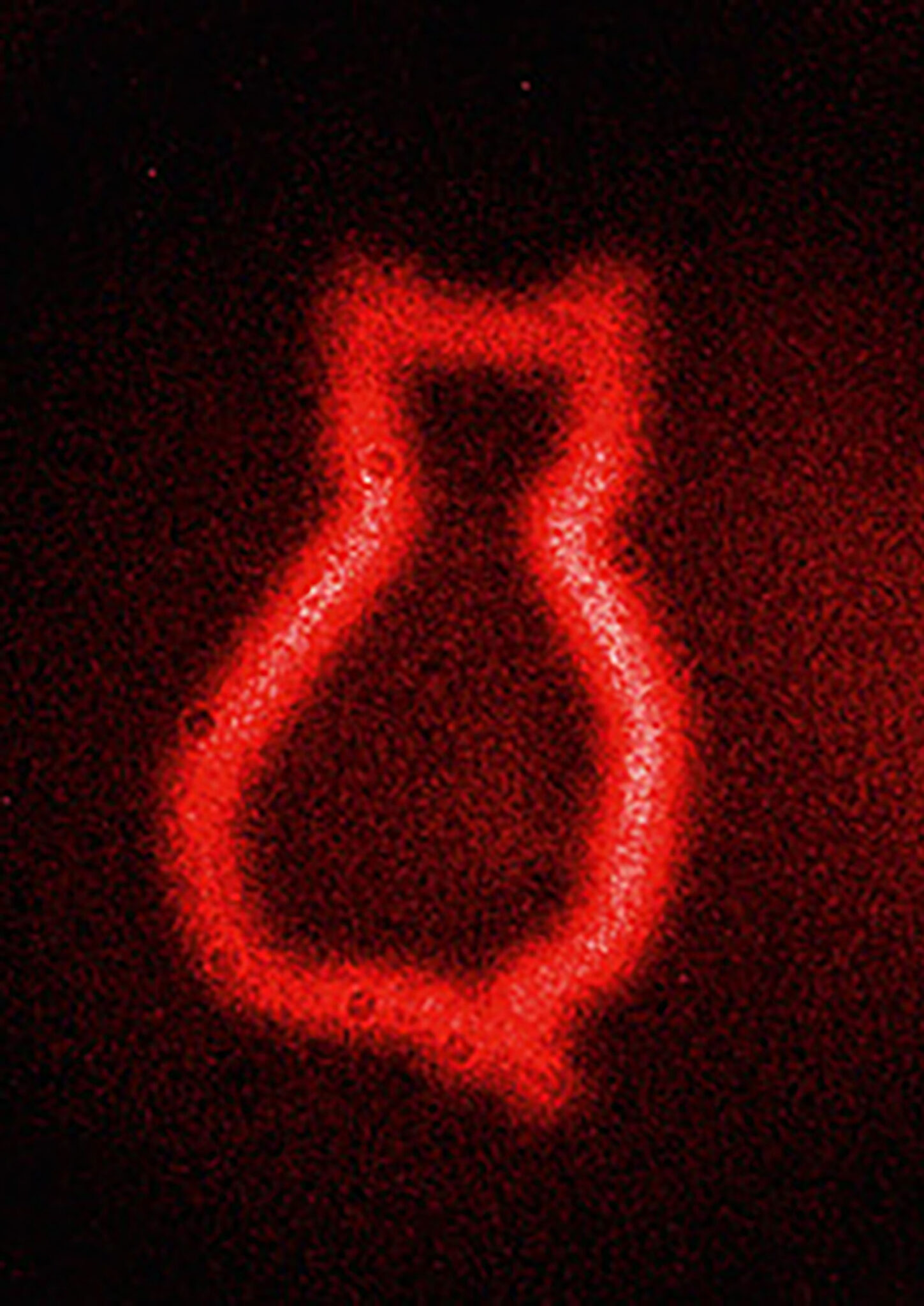
QUBIT AI: Gabriela Barreto Lemos
Quantum Photography
FILE 2024 | Quantico
International Electronic Language Festival
Gabriela Barreto Lemos – Quantum Photography – Brazil
Quantum photography technique that allows you to record images without light passing through the object.
Typically, a beam of light interacts with an object; In this same beam, the image of that object is formed, which is recorded on a camera, on paper or directly into the eye. This research used two quantumly entangled photon beams. An infrared photon was directed at a silicon wafer engraved with the image of a cat. The other photon, red, was sent on a different trajectory, did not pass through the silicon plate and was detected by an EMCCD (electron-multiplying charge-coupled device – a photographic camera with sensitivity to very low intensity light). The image of the cat engraving was recorded by the camera, which only detected the red light, which did not touch the engraving. It is the first time that an image has been captured in a beam of light that has not interacted with the object that produced the image.
The experiment, led by researcher Gabriela Barreto Lemos, was carried out at the Institut für Quantenoptik und Quanteninformation in Vienna, 2014.
The technique has potential for applications in indirect image capture, from medicine to quantum computing.
Bio
Professor at the Federal University of Rio de Janeiro, in Brazil, whose research focus is on quantum optics, with an emphasis on quantum foundations, quantum images and quantum information. Additionally, she is involved in interdisciplinary creative projects and promoting inclusion and diversity in science.
Credits
Gabriela Barreto Lemos
Vienna Center for Quantum Science and Technology
Institut für Quantenoptik und Quanteninformation
Group of Anton Zeilinger

MASAKI FUJIHATA
beyond pages
The data projector loads images of a leather bound tome onto a tablet which a light pen activates, animating the objects named in it – stone, apple, door, light, writing. The soundscore immaculately emulates the motion of each against paper, save for the syllabic glyphs of Japanese script, for which a voice pronounces the selected syllable. Stone and apple roll and drag across the page, light illuminates a paper-shaded desklamp; door opens a video door in front of where you read, a naked infant romping, lifesize and laughing, in.
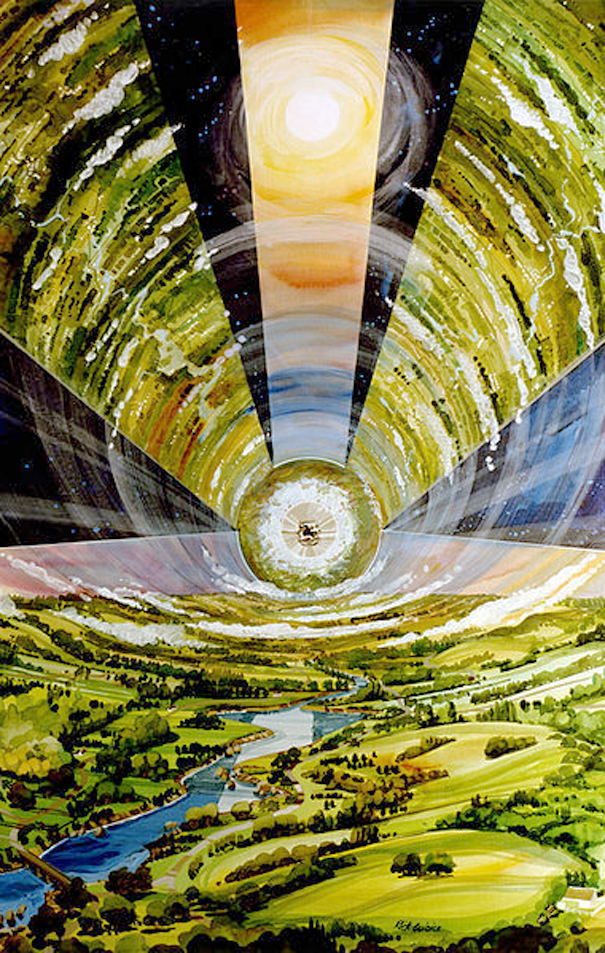
Gerard O’Neill
O’Neill cylinder
O’Neill was inspired by the papers written by his students. He began to work out the details of a program to build self-supporting space habitats in free space.Among the details was how to provide the inhabitants of a space colony with an Earth-like environment. His students had designed giant pressurized structures, spun up to approximate Earth gravity by centrifugal force . With the population of the colony living on the inner surface of a sphere or cylinder, these structures resembled “inside-out planets”. He found that pairing counter-rotating cylinders would eliminate the need to spin them using rockets.This configuration has since been known as the O’Neill cylinder.
SHU LEA CHEANG
Avatar do artista
“Para quem não a conhece, Shu Lea Cheang é uma figura da net art e do movimento ciberfeminista que surgiu na década de 1990. Na época, morando em Nova York, ela também era membro ativo do coletivo de vídeo ativista Paper Tiger Television (assim como a cineasta francesa Nathalie Magnan). Desde então, o trabalho de Cheang tem lidado com “questões que incluem sexo, futuro, gênero, ecologia, dinheiro, mídia e comida [para] englobar filme, instalação, trabalho online, processos sociais e intervenção direta nos sistemas sociopolítico, técnico e estético, e os imaginários que os compõem ”. Matthew Fuller

LAb[au]
What hath God wrought?
The title of the installation is a line from the Book of Numbers in early modern English. It was the first message transmitted by telegraph in 1844, the first communication technology on the basis of electricity and binary coding. The artwork is fed by the 100 most used words in Thomas More’s book ‘Utopia’, feeding the correspondence between a series of telegraphs. The telegraphs translate the words into sound and light. Written rolls of paper drift to the floor. Slowly but surely, mistakes slip into the closed system and the meaning of the words alters. The Morse orchestra deals with the rationalism of the Renaissance and its belief in progress and posits by contrast an aesthetic of a self-regulating system in which the fault rules and defect becomes beauty.
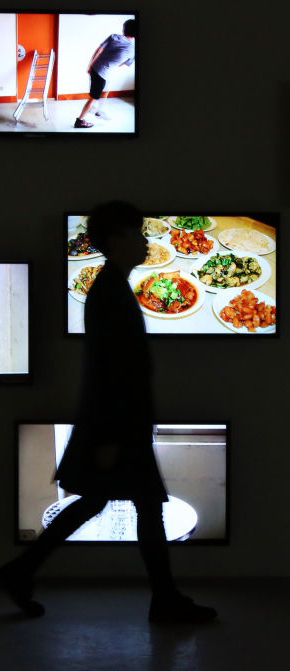
KOKI TANAKA
田中功起
Everything is Everything
The eight-channel video installation, Everything is Everything, was created for the first time to be shown at the 2006 Taipei Biennial, curated by Dan Cameron. For this work, the artist and two assistants spent a total of eight days recording their interactions and interventions with readily available items, including hangers, glasses, towels, air mattresses and toilet paper, all found in the city of Taipei. The physical properties of these objects have been tested (a metal hanger is stretched to the breaking point) or their uses have been expanded (a level placed on two table legs becomes an improvised obstacle). Tanaka and his assistants experimented with these objects several times indoors and in public, and their explorations were compiled into eight separate video loops lasting from 1:19 to 1:50 minutes. Tanaka’s narrowly cut frame of each scene often features performers from the neck down or removes them completely from the scene, thus focusing the viewer’s attention on the simple, repetitive objects and acts being performed.

Kerstin Ergenzinger
Wanderer Spacetime Poetry
Wanderer Spacetime Poetry is a continuously evolving installation series. Wanderers are small modified and individually programmed thermal printers that roam along paper strips that are stretched in different constellations across a space. On their journeys the Wanderers leave traces behind, a line, a dot or words. Like a snail with its trail the units dynamically create a poetic drawing over the course of an exhibition.

Stefan Tiefengraber
your unerasable text
“your unerasable text” is an interactive installation, dealing with the topics of data storage and elimination of data. The installation can be placed in an exhibition, but ideally it’s exhibited in a public space window, where it can be used by people passing by 24h a day. The participant is asked to send a textmessage to the number written on a sign next to the installation. “send your unerasable textmessage to +43 664 1788374”. The receiver mobile transfers it to a computer, which is layouting the message automatically. Then it is printed on to a DIN A6 paper, which is falling directly on to a papershredder. There the message remains readable for a few moments and gets destroyed then. The shredded paper forms a visible heap on the floor, which reminds of a generative graphic.
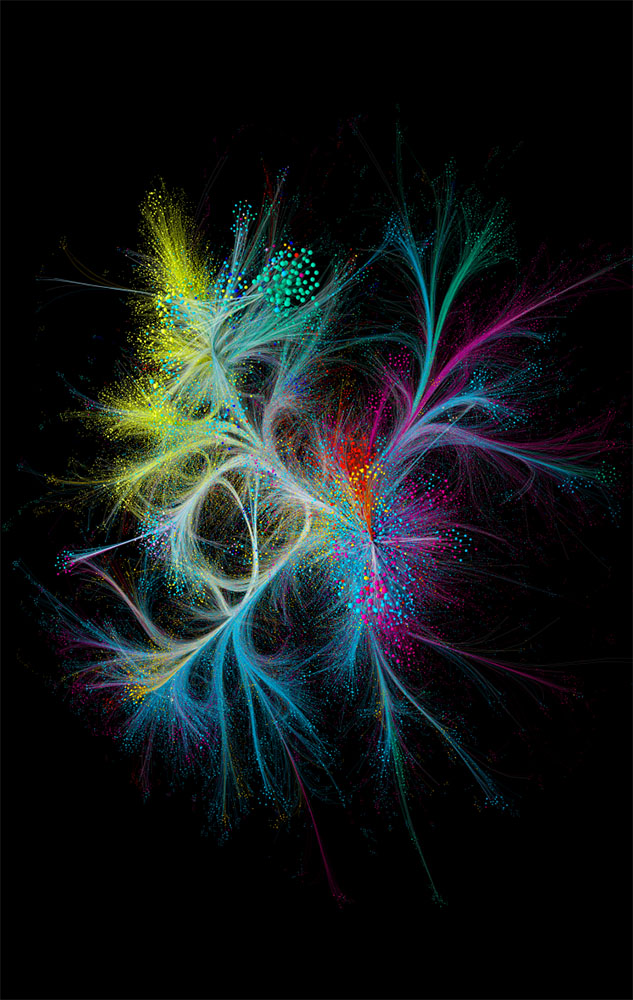
BarabásiLab
Hidden Patterns
The co-citation network for Nature: more than 88,000 papers published by the journal since 1900 are each represented by a dot, coloured by discipline. Papers are linked if another scientific paper (of those indexed in the Web of Science) cites both; the dot size reflects the number of these co-citation links.
Invisible, hidden connections and constantly repeating patterns within nature, society, language, and culture can not only be explored but also made visible. Barabási’s network approach promises to deliver a comprehensive, universal method that will illuminate many phenomena with scientific precision.
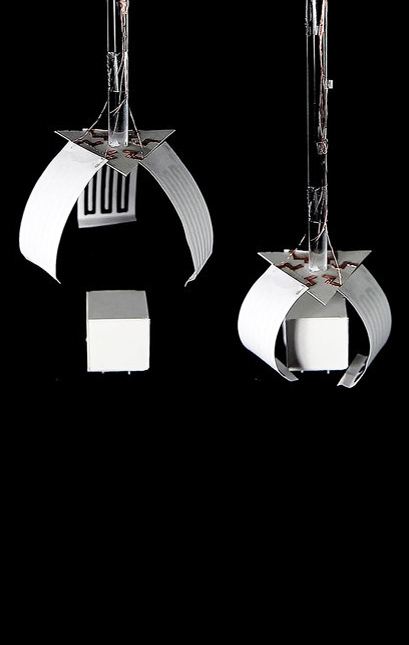
Morphing Matter Lab
Printed Paper Actuator
“Printed Paper Actuator is the project that achieves a low cost, reversible and electrical actuation and sensing method. This method that requires simple and easy fabrication steps enables our paper actuator to achieve different types of motion and even various electrical sensing abilities: touch sensing, slider, and self-bending-angle detection. We introduce a software tool that assists the design, simulation, and printing toolpath generation.” Morphing Matter Lab

VEGA ZAISHI WANG
베가 왕
维加王
ВЕГА ВАН
ALPHA LYREA
Beijing-based fashion designer Vega Zaishi Wang’s new Alpha Lyrae collection is very special. Silk dresses of her design were printed with galaxies, constellations, and nebulas, then backed with lightweight and flexible electroluminescent paper, making the garments glow. The name of the collection is quite clever: not only does it reference the space theme of the design, but Alpha Lyrae is the name of the brightest star in the constellation of Vega, which is also the designer’s first name.
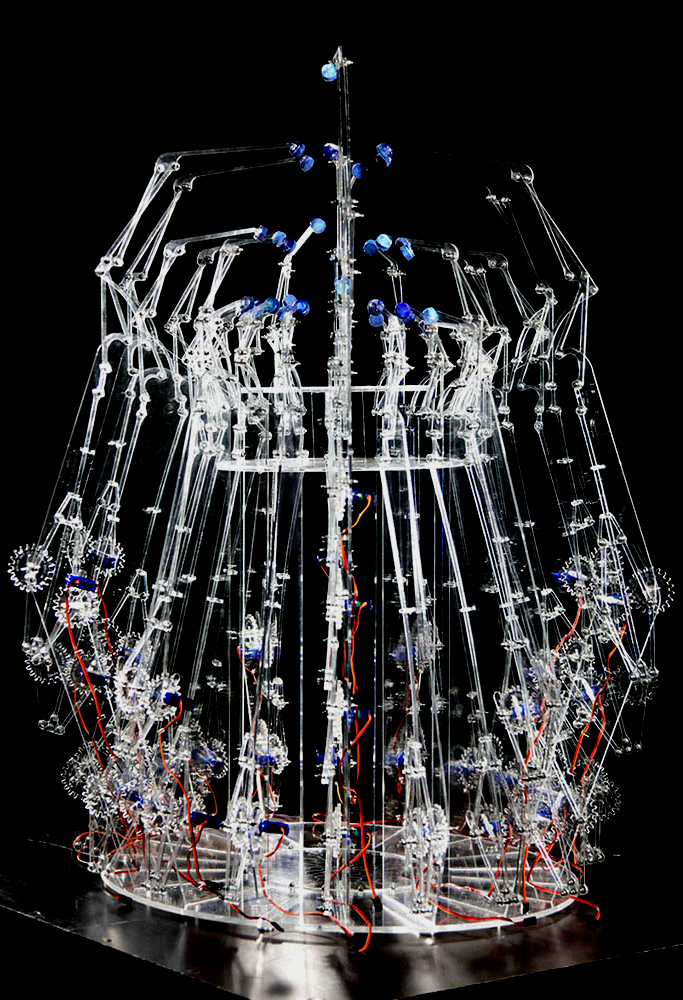
jeanine jannetje
reawaken
Reawaken is a kinetic sculpture with 55 robotic arms, powered by 55 servo motors. The lowering of the arms causes an abstract print on paper. Technology mirrors humanity, and vice versa. In addition to creating beauty, technology is there to meet our needs. We, and our needs, have evolved to a point where we are so integrated that we consume technology on autopilot. We live in a time of mass production in which our daily devices increasingly mimick each other. A smartphone is a small tablet, a tablet a small computer and a computer a small television. The question of what this does with our imagination, together with the increasingly invisible technological progress such as algorithms and artificial intelligence, have been my starting point for Reawaken.

Marleen Sleeuwits
INTERIOR N0. 58
Primarily working within abandoned office spaces, her process involves stripping the rooms down to their individual components, laying bare the layers found beneath the surfaces. She then re-assembles the room using materials found on-site, such as fluorescent tubes, paper towels, laminate, and tape, by adapting techniques of sculpture, painting and drawing.

Marta Revuelta
AI Facial Profiling, Levels of Paranoia

FIELD
System Aesthetics
The works in this series are part of an extensive research project by FIELD, exploring the most relevant machine learning algorithms in code-based illustrations […] We have started a deeper exploration of the less accessible information that is out there, such as scientific papers and open source code publications, to develop an understanding of these algorithms’ inner workings, and translate it into visual metaphors that can contribute to a public debate.

THORSTEN FLEISCH
Energie!
Thorsten Fleisch creates films that reveal the shapes and patterns of natural forces and phenomena. In this work he reveals what energy in one of its simplest forms looks like in motion. Energie! is a sequence of still images created on light-sensitive photographic paper. The artist exposed dozens of sheets of paper to enormous electrical discharges, each leaving its imprint as a trail of light. Animating these images reveals patterns in their flow of energy, akin to tracing the flow of electricity at each moment of a lightning strike. As the images are photographs created without cameras, they are records of single moments. Accordingly we see dozens of split-second documents animated to reveal the shape and power of energy.

Shu Lea Cheang
Avatar of the artist
Taiwan in Venice 2019
“For those who don’t know her, Shu Lea Cheang is a figure of Net art and the cyberfeminist movement that emerged in the 1990s. Living in New York at the time, she was also an active member of the activist video collective Paper Tiger Television (as was French filmmaker Nathalie Magnan). Since then, Cheang’s work has dealt with “concerns including sex, futures, gender, ecology, money, media, and food [to] encompass film, installation, online work, social processes, and direct intervention in the sociopolitical, technical and aesthetic systems, and the imaginaries which co-compose them,” writes Matthew Fuller
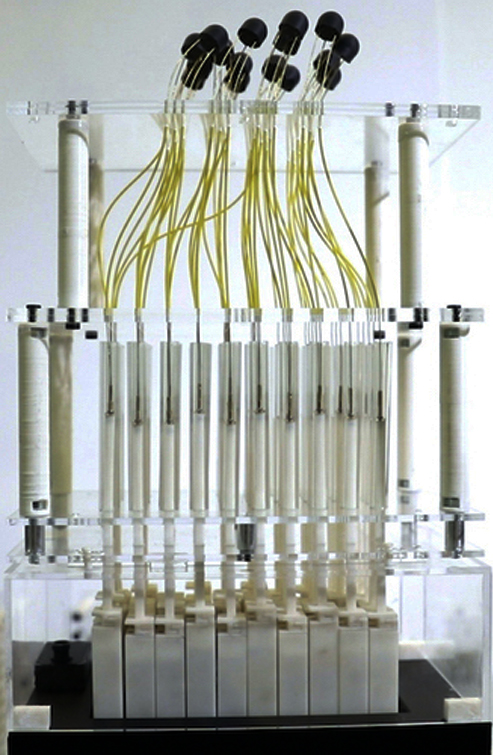
tangible media group
transdock
Ken Nakagaki, Yingda (Roger) Liu, Chloe Nelson-Arzuaga, and Hiroshi Ishii
TRANS-DOCK is a docking system for pin-based shape displays that expand their interaction capabilities for both the output and input. By simply interchanging the transducer modules, composed of passive mechanical structures, to be docked on a shape display, users can selectively switch between different configurations including display sizes, resolutions, and even motion modalities such as rotation, bending, and inflation.
In our paper accepted to TEI 2020, we introduce a design space consisting of several mechanical elements and enabled interaction capabilities. Our proof-of-concept prototype explores the development of the docking system based on our previously developed 10 x 5 shape display, inFORCE. A number of transducer examples are shown to demonstrate the range of interactivity and application space achieved with the approach of TRANS-DOCK.
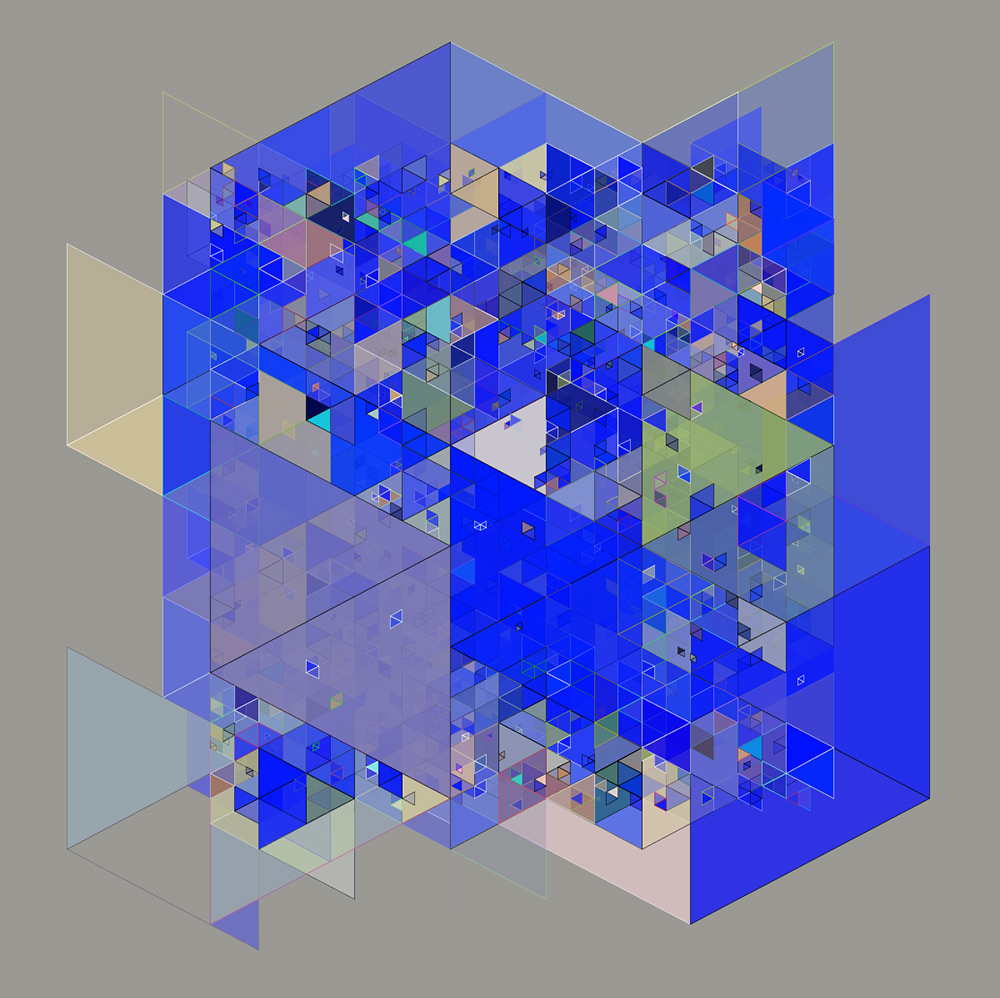
HOLGER LIPPMANN
TriangPaint
Holger Lippmann describes a part of his work as digital painting. What distinguishes digital painting from traditional painting on canvas or paper? We need to distinguish between two categories of digital painting. The first includes works created on the computer with ready-made graphic tools like virtual paint brushes or pens, in something like the way that non-digital pictures are created on paper or canvas. David Hockney’s painting of a sunflower on an i-pad is an example of this. The second category includes works using computer generation, in which programs coded by the artist continually produce new aesthetic concepts as images or animations. Every execution of the software creates new works within the pre-defined boundaries of the system. This process can be called generative painting.

THOMAS HEATHERWICK
Bombay Sapphire Distillery
The existing buildings at the complex were built during the Victorian era to house a mill that produced paper for English bank notes. The buildings were later abandoned and left derelict until the complex was bought by Bombay Sapphire, the gin brand owned by alcoholic drinks giant Bacardi, who commissioned Heatherwick to overhaul the site, creating a new distillery and visitors’ centre […] Two curving glass greenhouses form the major new additions to the site. Hot air is channeled into the greenhouses through large pipes clad in strips of metal, picking up heat produced during the distillation process and carrying it out through openings in the red-brick walls of one of the existing buildings.

MARK HANSEN & BEN RUBIN
“Moveable Type”
In the entrance hall of the New York Times Building there is an installation made by Mark Hansen and Ben Rubin “Moveable Type” with hundreds of small monitors where fragments of the newspaper’s electronic files, words, phrases, quotations, places, crosswords, etc… permanently appear in an endless series of combinations.
.

Stephen Scott
Bowed Piano
Few chamber groups deploy their musicians as oddly as the Bowed Piano Ensemble. The 10 players, students led by the composer Stephen Scott, stand around, and sometimes under, a concert grand, armed with items of all kinds — nylon fishing line, piano hammers, guitar picks, strips of paper, rolls of plumber’s tape — and reach into the instrument to draw sounds from its strings.

Daikoku Design Institute
The Petal Room
The Petal Room consists of 3,500 real flowers, 6 million paper petals designed to fall with beautiful trajectories, a signature scent, and sensor-activated lighting that incorporates microscopic scans of flowers. These elements stimulate the senses and allow visitors to feel physically connected to flowers and nature.


Hansje van Halem
w for w
Hansje van Halem has run her studio in Amsterdam since 2003. In between deadlines for book designs, she fills time gaps with type drawings and empty book space with patterns. With a “practice makes perfect” mind-set, she taught herself not to be afraid of failure. Her time gaps soon took the upper hand and became her core business. While working on commissions from patterns for endpapers, architectural typography, and all scales in between, she creates a lot of overproduction.

MAURIZIO CATTELAN
マウリツィオ·カテラン
Маурицио Каттелана
Ci sono artisti che creano spunti per le riviste, e ce ne sono altri che si inventano riviste per darsi degli spunti. È il caso di Maurizio Cattelan, controverso esponente del panorama creativo contemporaneo, padovano di nascita ma “americano” per scelta, autodidatta e poi manager di sé stesso, autore, tra le altre cose, di happenings tra i più chiacchierati della storia dell’arte, quali forma di provocazione visiva estrema. Non bastassero le sue stesse produzioni a muovere gli animi, ci si mette pure una collezione, firmata a suo nome, di immagini raccolte qui e lì per poi essere impaginate insieme in un unico giornale, Toilet Paper, ideato dall’artista stesso in coppia con il fotografo Pierpaolo Ferrari e pubblicato dalla Deste Foundation for Contemporary Art di Atene.
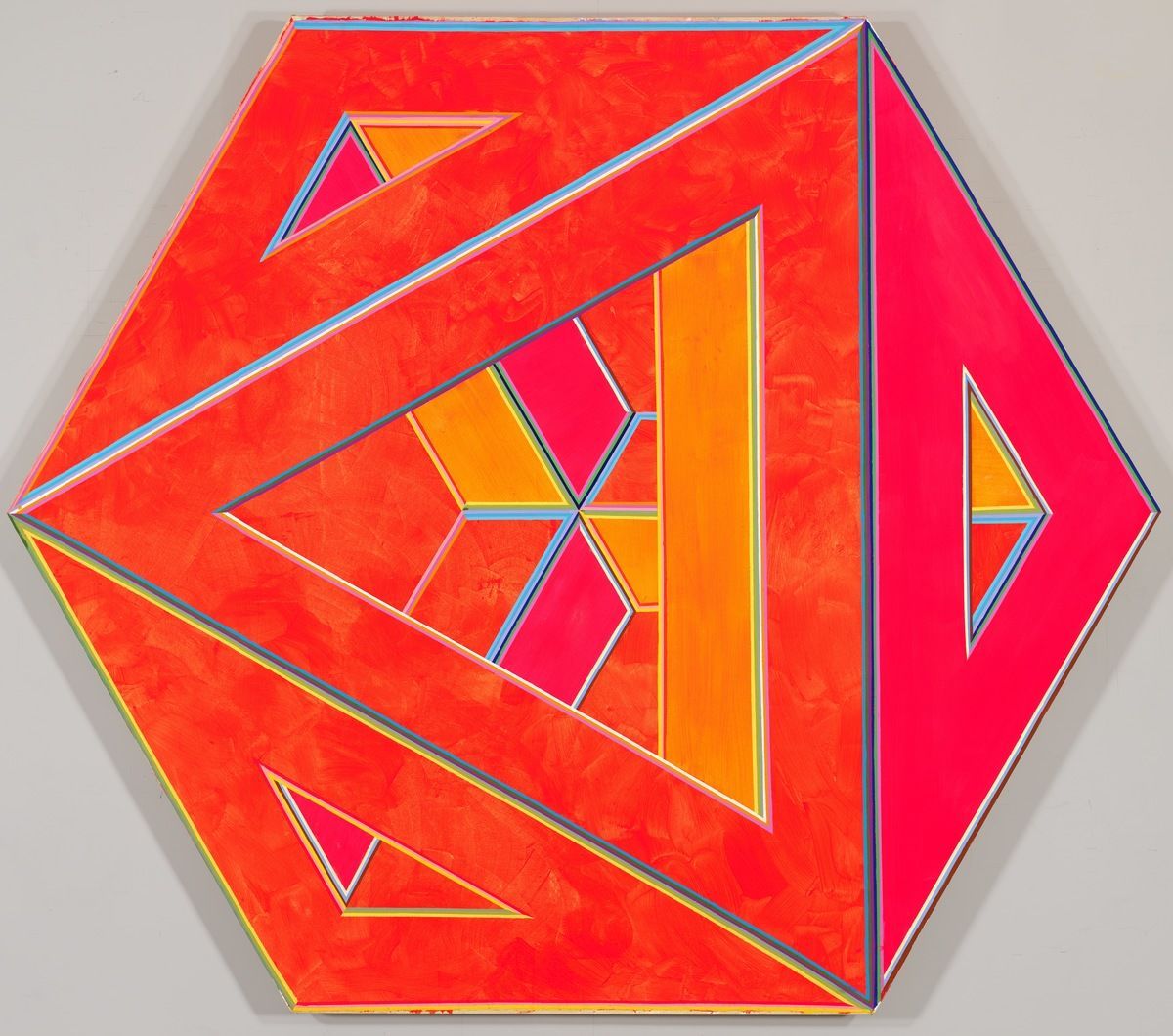
Alvin Loving
His work is known for hard-edge abstraction, fabric constructions, and large paper collages, all exploring complicated color relationships.
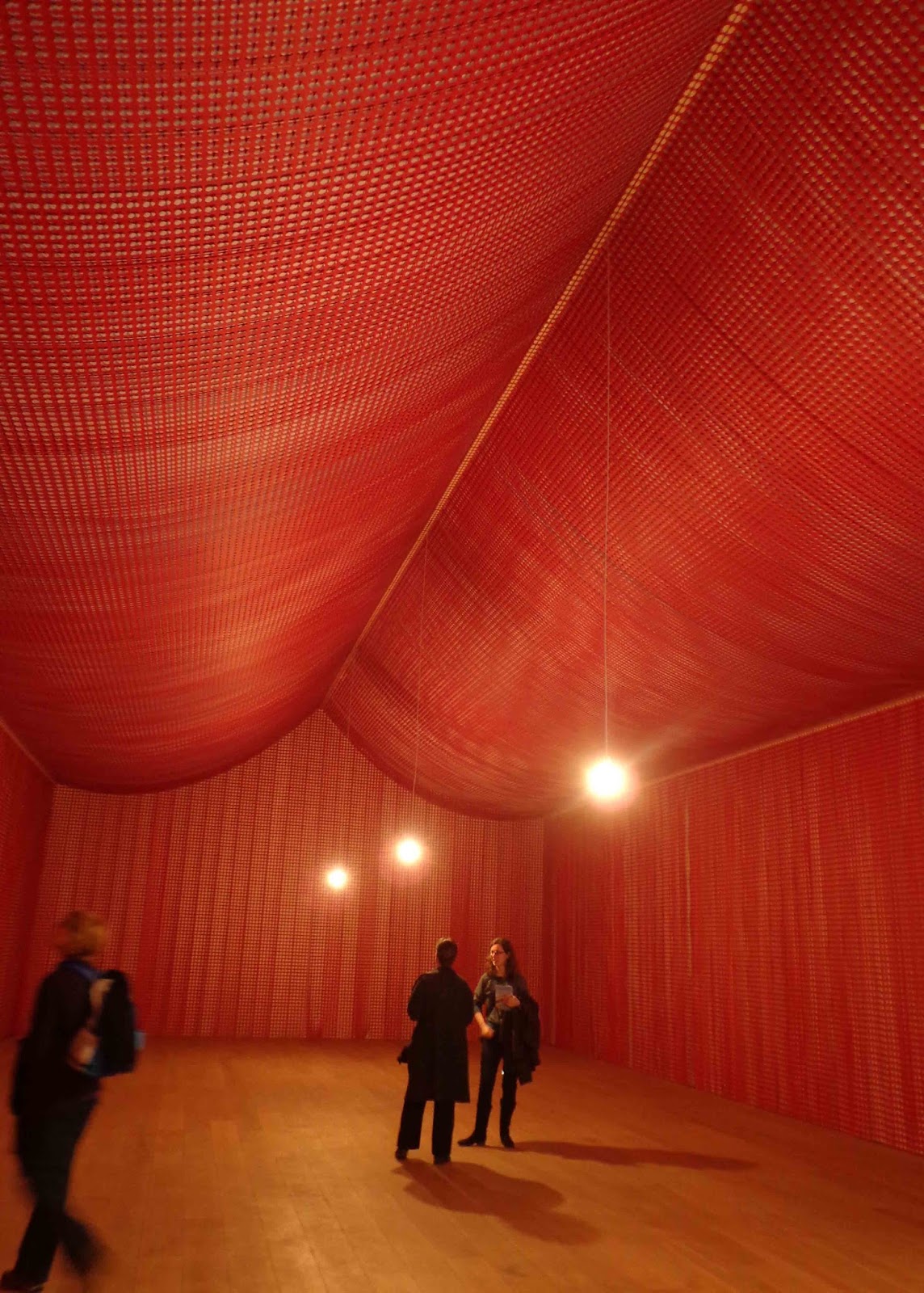
Cornelia Parker
War Room
“There were poppies as far as the eye could see,” says Cornelia Parker RA of her recent trip to Aylesford in Kent. But she is not talking about real flowers. She is recalling a visit to the village’s huge factory that produces paper poppies for Remembrance Day. This led to her new work War Room (2015, above), on view as part of her survey show at the newly refurbished Whitworth Gallery in Manchester.
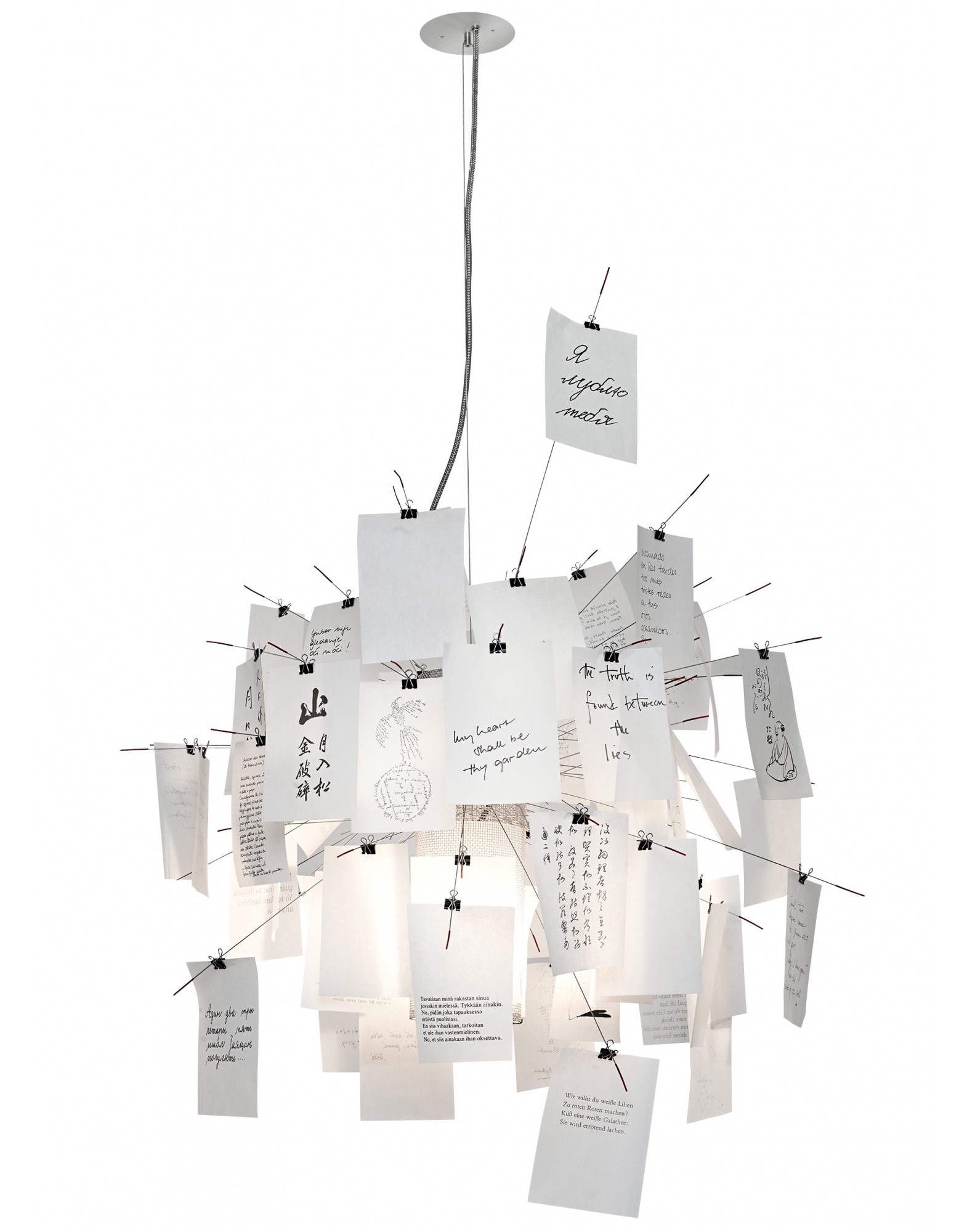
Ingo Maurer
ZETTEL’Z 6
HOMAGE
R.I.P
Japanese paper, stainless steel, heat-resistant satin-frosted glass. Zettel’z Munari is a new limited edition of Zettel’z 5. With the illustrated alphabet by Bruno Munari, it is a perfect luminaire for rooms where children live, to be surrounded by creativity and the curiosity to explore language and learning. However, with its unique beauty, the limited edition is a pleasure for all ages. For Zettel’z Munari, Ingo Maurer received the permission of the publishing house Maurizio Corraini srl to use the alphabet by Bruno Munari.

ingo maurer
oh mei ma weiss
The Oh Mei Ma Weiss Chandelier (also known as the Oh Mei Ma White Chandelier) by Ingo Maurer is fashioned from six sheets of aluminum with a matte-white lacquered textured paint finish. This stylish Ingo Maurer lamp is a sensation to behold. Ingo Maurer’s Oh Mei Ma Weiss is a true classic and a fine example of Ingo Maurer’s artistry. Oh Mei Ma Weiss is composed of 6 thin aluminum shades which are suspended from thin metal cables. The aluminum paper shades are nested above each other to create a soft diffusion of light throughout a space.

Heatherwick Studio
Friction table
This table is made from resin-infused paper, which is incredibly durable, highly sustainable and one of the few materials stable enough to achieve the level of precision required. At 1.8 metres when in its round form and 4 metres when extended to its longest ellipse, the Friction Table can seat groups of eight.
Well Well Designers
Pixel geante
Well Well Designers are a couple that set up a business creating lights out of paper. I like the idea of having a pop up lamp, I think it is really creative and is perfect for modern apartments. I would like to look at ways of creating my own pop up lamps that give off an array of shadows, different ones for different moods.

MOUNIR FATMI
منير فاطمي
Evolution or Death
Fatmi inverts spectacular representations of identity by rendering them mundane and within reach of a subject that may scramble any conclusive narrative. Fatmi’s work counters strategies of interpellation that identifies a subject with an ideology prior to that subject’s ability to place their identity in or beyond a particular ideology. Fatmi parodies the various interpellations of colonialism and capitalism that seek to define others according to symbolic narratives. In Evolution or Death, 2004, (fig. 4) two Anglo-European looking subjects imitate suicide bombers with books and papers taped around their abdomens. One holds open a trenchcoat and another holds up a book that looks like a detonator attached to wires. Fatmi reverses the situation. These are not the suicide-bombers from Arab and Muslim countries. Instead, they appear to be of European descent in a European street or modern room in casual clothing.
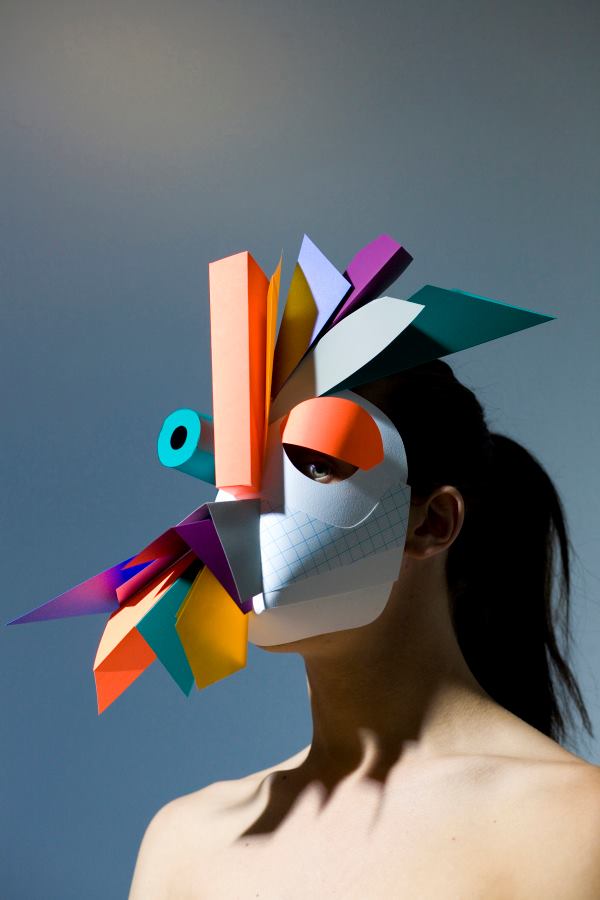
BENJA HARNEY
Having made his first paper sculpture at 25 while studying graphic design at Enmore TAFE, Harney – who works under the tag of Paperform – has since gone on to become one of Australia’s most prominent and creative paper engineers, with his incredibly intricate, detailed, lifelike paper sculptures, pop-up books, objects and backdrops commissioned by brands, galleries and commercial and editorial clients from around Australia and the world.

Tinguely
Méta-Matics
“Meta-matic drawings vary enormously, entirely according to how the machine is set up and used. No two drawings are ever completely identical. How close the felt-pen, or whatever is being used, is fixed to the paper, is an important factor, but the fluidity or otherwise of of the coloring agent, or the texture of the paper, will also play a part. The operator can use pencil, ballpoint, airmail stamps, invisible ink . . . The decisive thing is how long the machine is allowed to run without interference, and how long with each separate colour. But however it is set up, it is impossible for the machine to produce an ugly drawing”. Hultén

Koto Bolofo
Arjowiggins skin paper
After living as political refugees for nearly 25 years, Bolofo and his father returned to South Africa, an experience documented in his short film The Land Is White, the Seed Is Black. His keen eye for lively, dynamic images has won him accolades for his fashion photography[…]
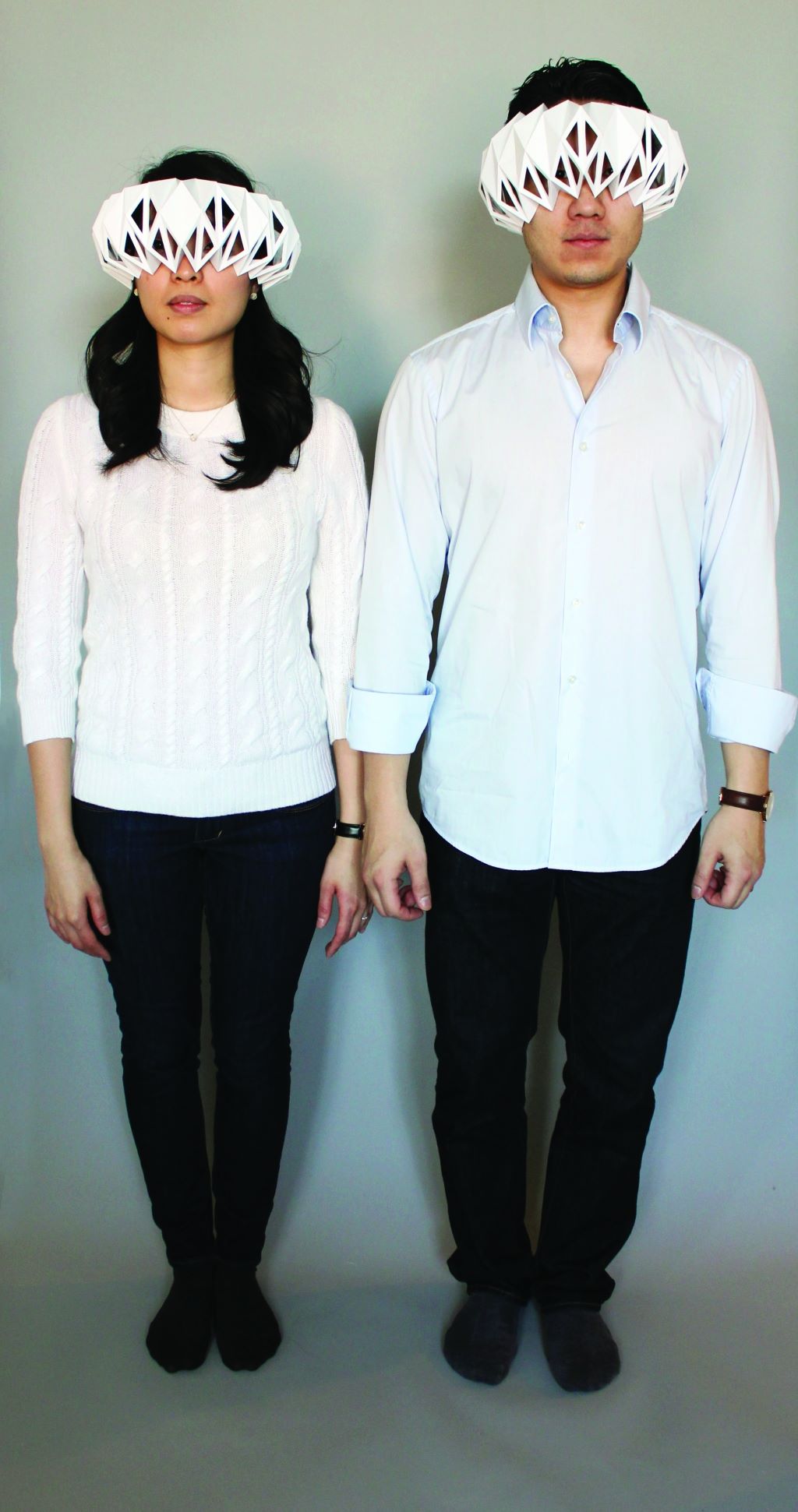
Christine Kim and Marcin Kedzior
Paper Orbs
Paper Orbs begins the night as a massive origami sculpture which dissolves into thousands of paper helmets worn by visitors as they parade down University Avenue. As both a lantern and a center of gravity, the paper float pulls visitors in and encourages them to return throughout the night to experience the dissolution of the paper sculpture. The accumulated paper helmets disperse into scattered constellations that float along the street. The helmets also resonate with notions of patterned order and militaristic armour.
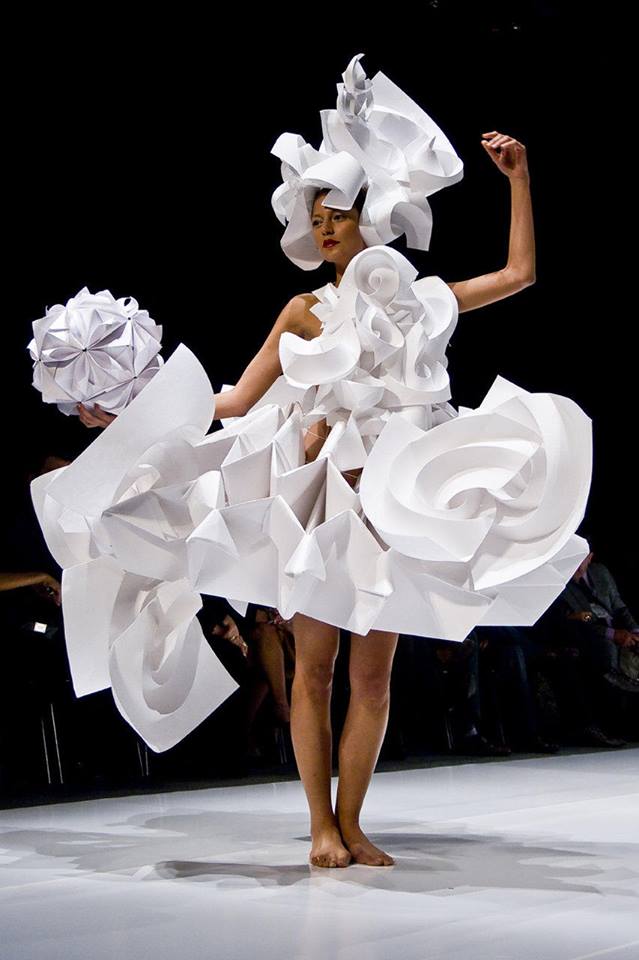
DIANA GAMBOA
ديانا جامبوا/
戴安娜甘博亚/
Диана Гамбоа
Diane Gamboa has been producing, exhibiting, and curating visual art in Los Angeles for more than 20 years. From 1980 to 1984, she photographically documented the punk rock scene in East Los Angeles. Between 1980 and 1987, she was a member of ASCO, a conceptual multi-media performance art group. During this time she also organized numerous site-specific “Hit and Run” paper fashion shows. Created as easily disposable streetwear, Gamboa’s paper fashions became quite popular, and some were even exhibited in museums.
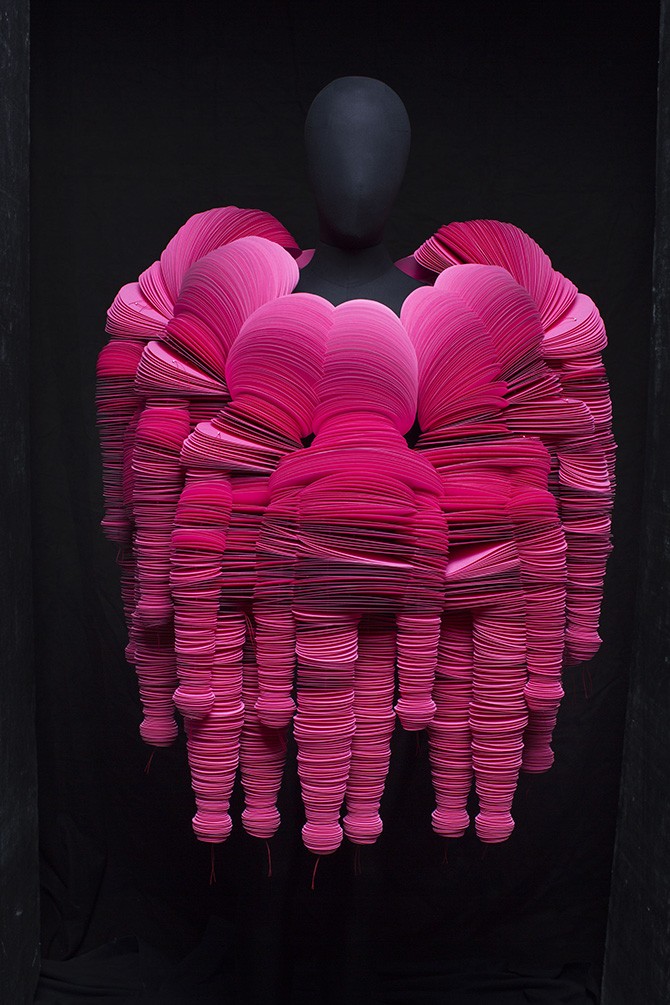
Bea Szenfeld
Paper Ensemble
Never coming up flat is the work of Bea Szenfeld, a Polish-born, Stockholm-based artist whose medium is paper. Szenfeld worked as a ceramicist and sculptor before pursuing a fashion degree at Beckmans College of Design in Stockholm. After graduating, she landed a job in the industry. Quickly realizing that working with commercial clothes was not her thing, she “jumped back to work with clothes in art.”
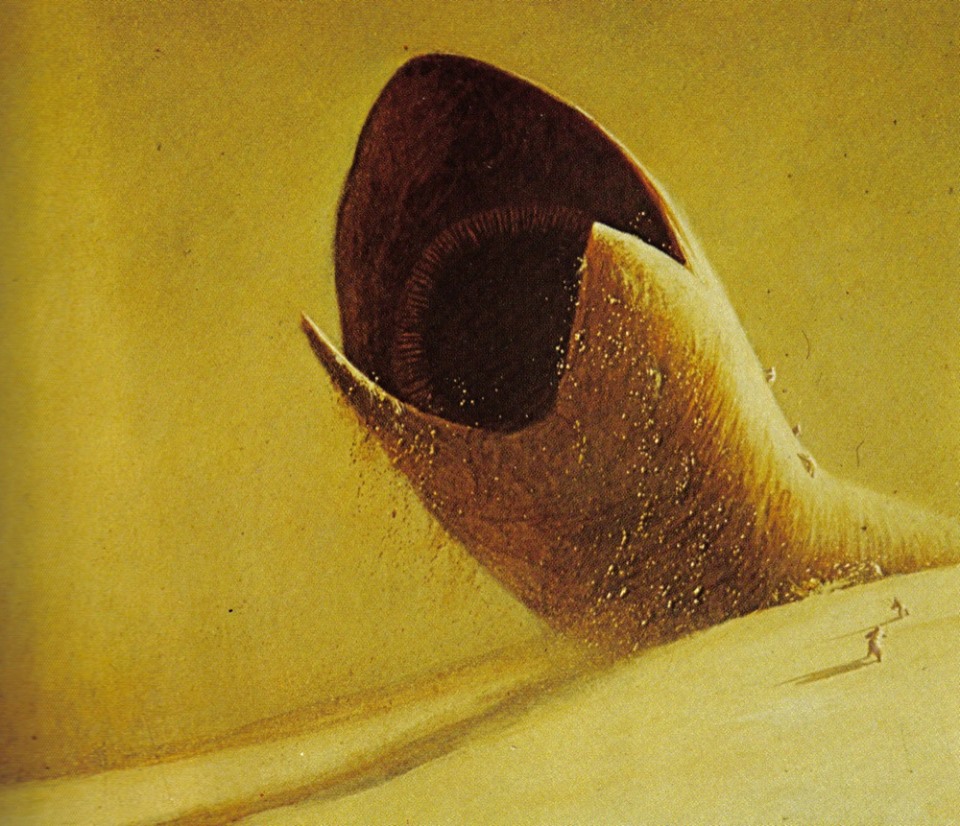
FRANK HERBERT
فرانك هربرت
弗兰克·赫伯特
프랭크 허버트
פרנק הרברט
フランク·ハーバート
Фрэнк Герберт
Dune: Children Of Dune
The major career break for Frank came after John Campbell serialized Dune in 1963-4 for the new Analog. Two more Dune books followed, Dune Messiah and Children of Dune creating a Dune Trilogy. Some years later, three more Dune books were added. Herbert’s livelihood career was as a newspaperman, working many of the west coast cities from Los Angeles to Washington state with 10 years spent with the San Francisco Examiner. He and his wife had three children, one of whom, Brian Herbert, became a SF writer in his own right.

ARAM BARTHOLL
0,16
0,16 is a light installation in which the shadows of a passer-by is transformed into ‘pixels’. The installation consists of a wall built of small square frames covered front and back with transparent paper. A third layer of paper is attached in the centre of the frames. A lamp shining at a distance breaks the shadows of the passers-by into squares, allowing a pixellated human figure to be seen on the other site of the installation. In this simple way, Bartholl renders tangible the pixels found in the world of digital communications.The ‘resolution’ of the screen is 0,16 ppi (pixels per inch), hence the title.

JESSE HOULDING
Loop Drawing Machine
The Loop Drawing Machine is a kinetic sculpture that uses magnets and iron filings to draw on paper. The friction of the iron on the paper both makes marks on the paper and pulls the paper through the machine; drawing a loop on a loop of paper. A chamber and auto-feed replenishes the iron as the magnets revolve past the feeder. Eventually the paper becomes a completely darkened by the overlapping marks.
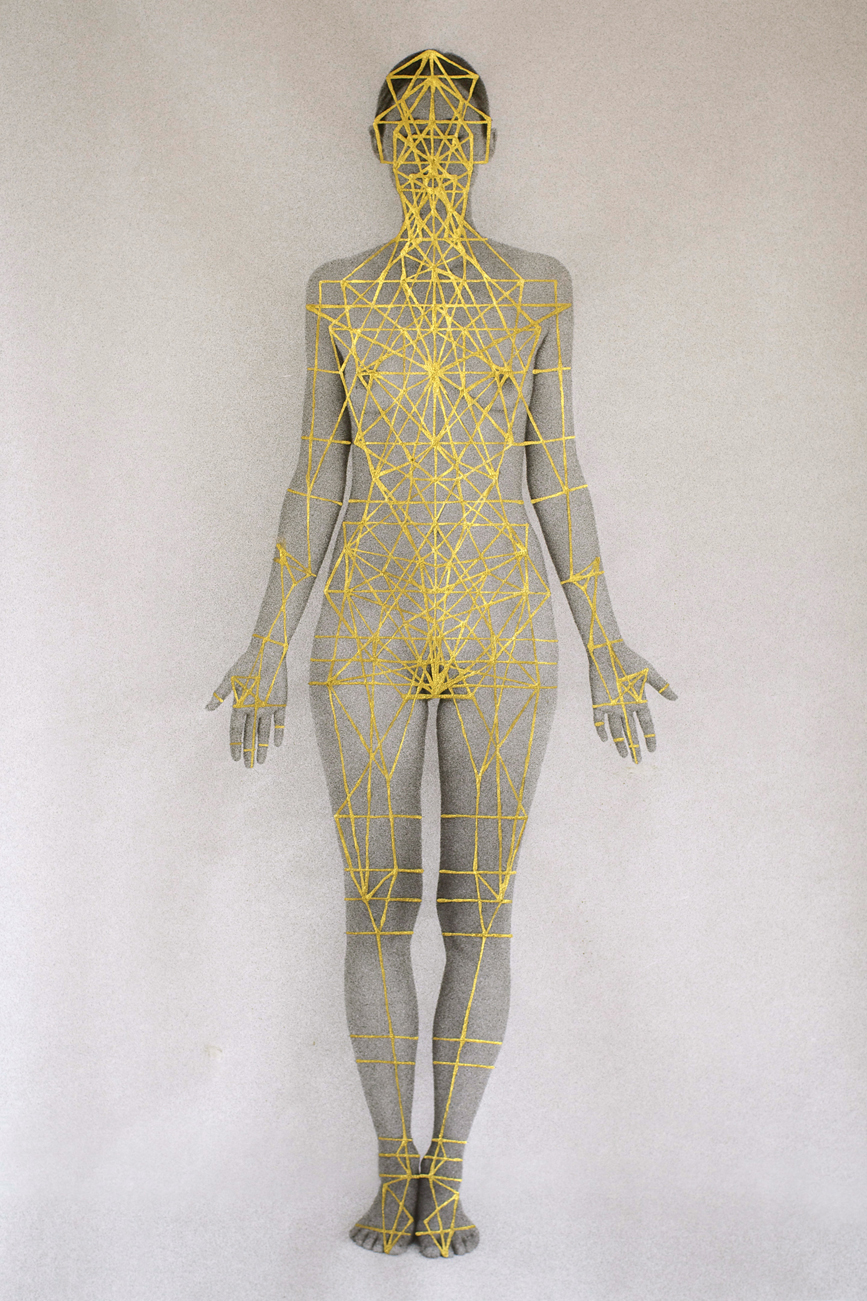
rachel garrard
Body Systems I
British-born artist Rachel Garrard creates a range of multi-disciplinary work that explores the great unknown, looking to quantum physics and other theories of the universe for inspiration and guidance. Both her video performance pieces and works on paper capture, despite their earthly limitations, the infinite nature of life on this planet and beyond. In a personal statement on her blog, the artist explains “that exploring the outer reaches of the universe can be similar to exploring the inner reaches of the human psyche and that both are governed by the same forces.

RACHEL PERRY WELTY
雷切尔·佩里韦尔蒂
Lost In My Life
American artist Rachel Perry Welty makes use of the scads of everyday items we tend to throw away in her new ‘Lost in my Life’ series. She layers the often overlooked items to create a whole new textured landscape. “Most of us don’t pay much attention to the mundane objects we use everyday,” explains Welty, “like the twist ties that hold the plastic wrap on our bread and the broccoli together or the little paper cups that we pull out of a water dispenser.”
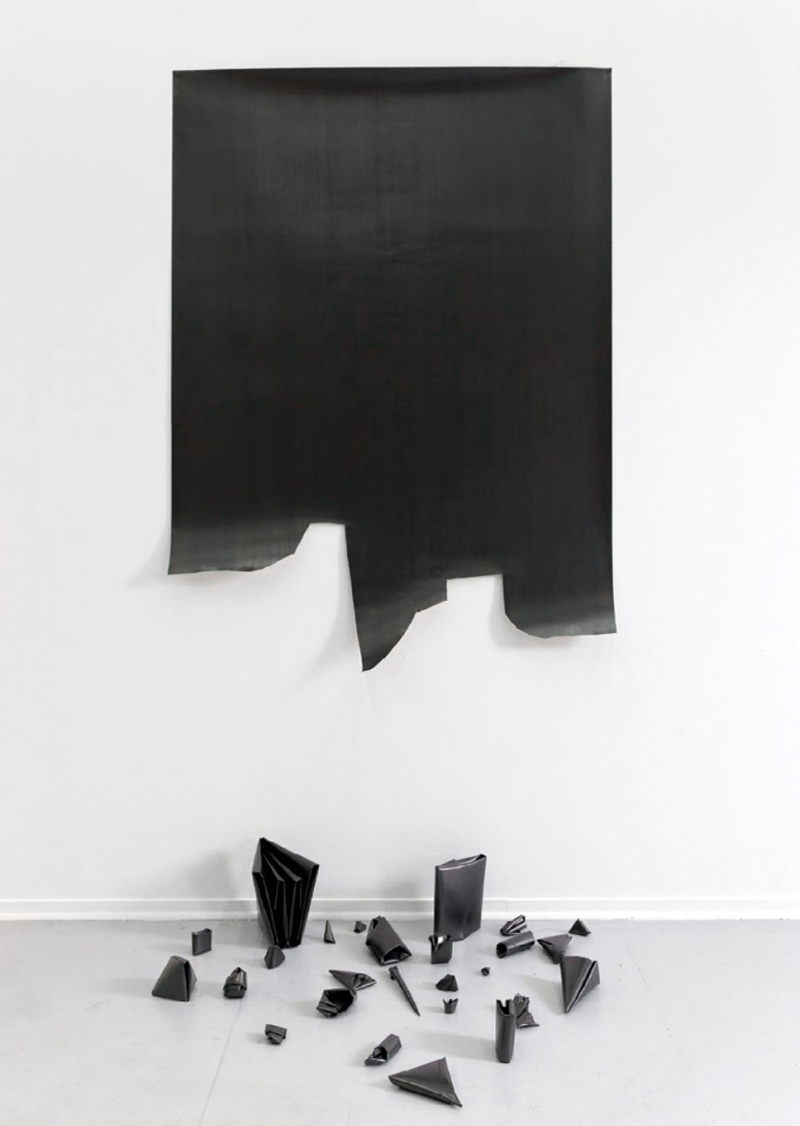
DIOGO PIMENTÃO
For ten years, Diogo Pimentão seeks to open the horizon of the drawing and its conventions to other dimensions, other processes and other tools. The act of drawing involves a relationship with him close to the body choreography, which determines the scale of the work: papers mechanically bent by hand to the major compounds of monochrome black lines drawn by the body in motion.
Therefore, the paper or the wood surface no longer appears as flat surface but as a flexible plan, foldable, stretchable, may become volume.

